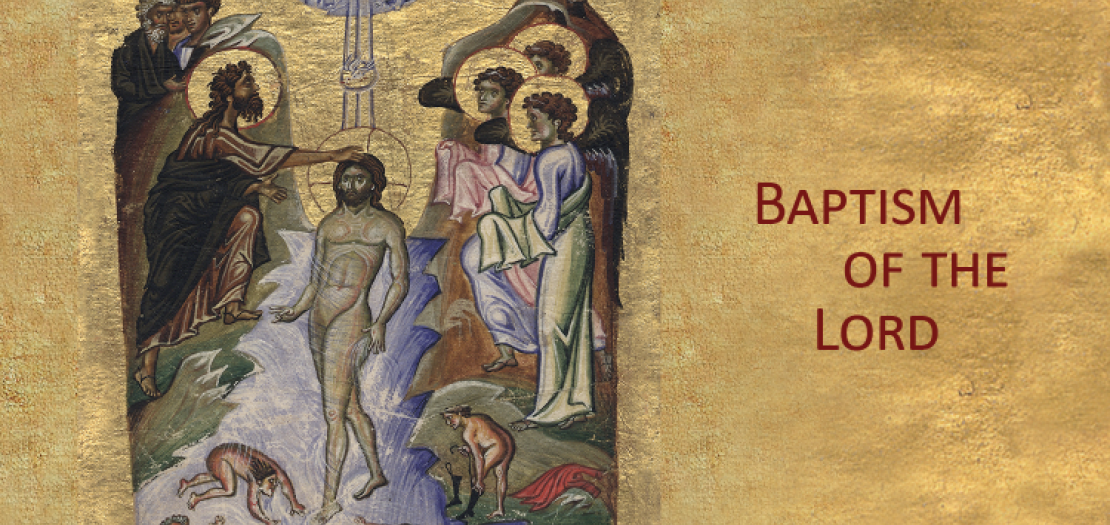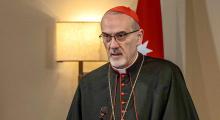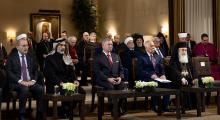Issued by the Catholic Center for Studies and Media - Jordan. Editor-in-chief Fr. Rif'at Bader - موقع أبونا abouna.org

Already in 300 AD, the Eastern Church celebrated the Epiphany and the Baptism of Jesus on 6 January. In the Western Church, this feast was mentioned in the Liturgy of the Hours. With the reform of the liturgy in 1969, the date for this Feast was set on the Sunday after the Epiphany. When the Feast of the Epiphany is not celebrated on 6 January, it is celebrated on the Sunday between 2 and 8 January, and the Feast of the Baptism of the Lord is celebrated on the Monday following the Epiphany. The Christmas Season concludes with the celebration of this Feast, even though a “window” is left open until 2 February, the day on which the Feast of the Presentation of the Lord in the Temple is celebrated. The latter feast is also known as Candlemas since Christ is proclaimed as the “light for the gentiles”.
Anno A
Then Jesus came from Galilee to John at the Jordan to be baptized by him. John tried to prevent him, saying, “I need to be baptized by you, and yet you are coming to me?” Jesus said to him in reply, “Allow it now, for thus it is fitting for us to fulfill all righteousness.” Then he allowed him. After Jesus was baptized, he came up from the water and behold, the heavens were opened, and he saw the Spirit of God descending like a dove [and] coming upon him. And a voice came from the heavens, saying, “This is my beloved Son, with whom I am well pleased” (Mt. 3:13-17).
Jesus along the Jordan
The Gospel passage begins with a geographical annotation: Jesus goes from Galilee to the Jordan to be baptized by John the Baptist. On His arrival, Jesus does not declare Himself to be the Messiah, He does not preach. Instead, He stands with everyone else there, wanting to be baptized, thus manifesting his solidarity with the sinful people. Jesus does not isolate Himself, but He goes out among the people, even those marked by the wounds of sin. He puts Himself at risk by being with them, just as He put Himself at risk by becoming Man in the womb of Mary. There is, therefore, a consistent design in how Jesus “moves about” along His “itinerary of salvation”.
John the Baptist
“I need to be baptized by you, and yet you are coming to me?” the Baptist says on seeing Jesus. We witness the prophet’s bewilderment who just a few verses earlier expressed himself thus: “The one who is coming after me is mightier than I. I am not worthy to carry his sandals …” (Mt 3:11). It seems to be the same bewilderment Peter experienced in Caesarea when, having reproved Jesus after the revelation of the Passion, death and resurrection that awaited Him, saying, “God forbid, Lord!”, hears the Lord’s reply, “Get behind me, Satan! You are an obstacle to me. You are not thinking as God does, but as human beings do” (Mt 16:22-23). Another time was in the Upper Room when Peter refused to allow Jesus to wash his feet (cf. Jn. 13:6-8). Reactions such as the Baptist’s and Peter’s reveal our discomfort at seeing Jesus so weak and yielding.
“Allow it”
There are moments when it is important to “allow things to happen”. What seems so abnormal that John the Baptist feels embarrassed is, however, part of God’s plan that will “bring to fulfillment” every righteousness, since Jesus – as He Himself would one day declare – did not come to abolish the law and the prophets (cf. Mt. 5:17), but to bring God’s justice “to fulfillment”. This justice does not humiliate, does not separate, does not judge. Rather, it unites, breaks down barriers, responds to everyone’s needs and respects everyone. God’s justice is superior than human justice: He does not use the measuring stick of “how much” – you pay according to the measure that you have offended. Rather, He uses the measuring stick of love, mercy, forgiveness – the only measuring stick that can bridge distances and heal wounded hearts since it is from within that evil intentions are born (cf. Mk. 7:1-23).
The heavens opened
Jesus’ choice is confirmed with the opening of the heavens, with the gift of the Spirit and the voice of the Father that seals Jesus’ mission: “This is my beloved Son, with whom I am well pleased”. With the opening of the heavens, “justice” cancels the separation between humanity and God, bringing us back to the dawn of creation when the Spirit hovered over the waters. In Jesus, God the Father shows us the New Man, His beloved, the One who pleases Him. It was as if He were saying: “You make me so happy. I am so proud of you”. This happiness exists in each one of us because each of us bears God’s image within. We are made in his “image and likeness” (Gn. 1:26). No one can ever erase this image for “God looked at everything he had made, and found it very good” (Gn. 1:31). Jesus’ coming tells us that God is interested in us. It’s like He is saying, “With you, I want to begin a new story of salvation, a new beginning”. We are made new to the extent that we learn to recognize life as a gift of love and that we live in this Love.







